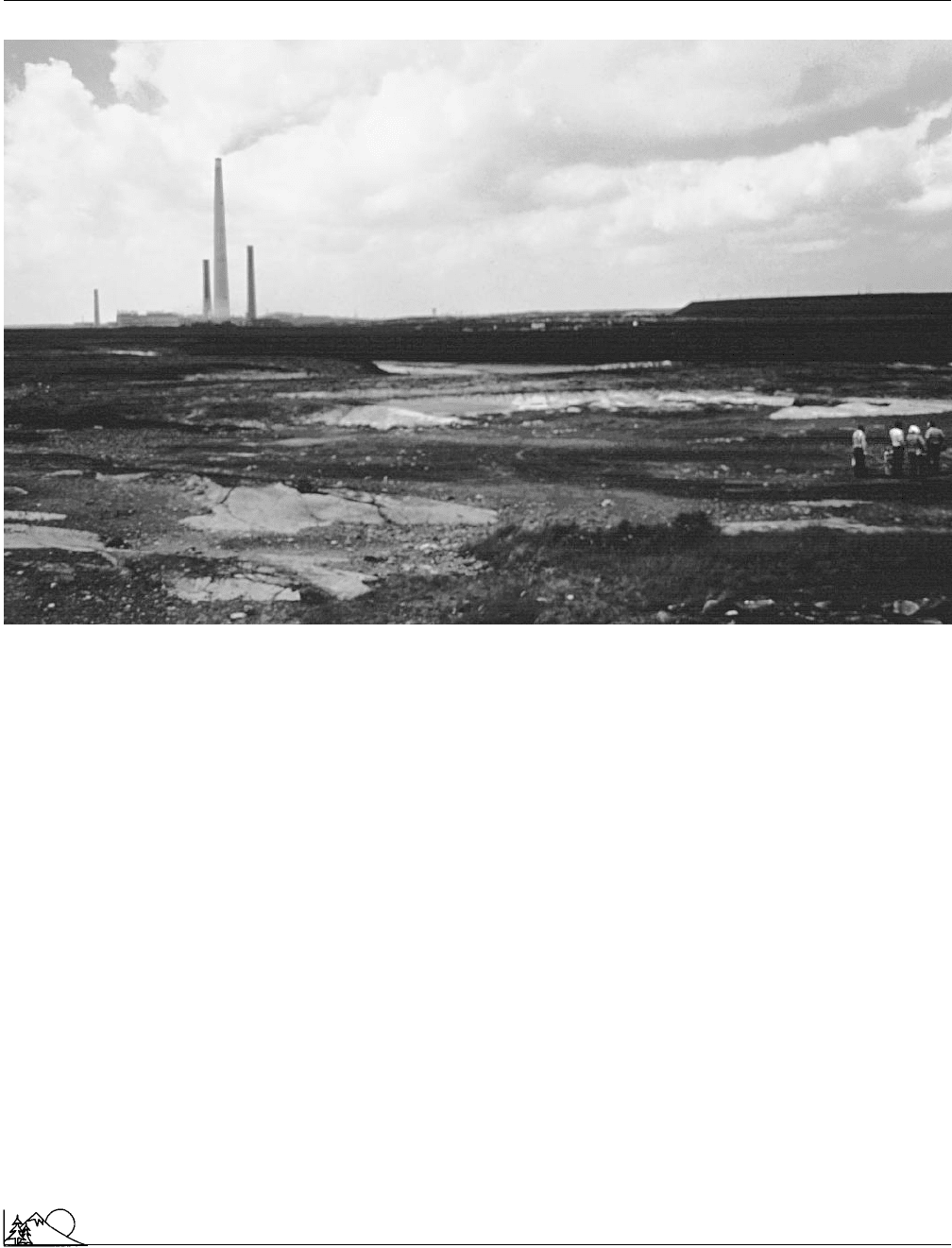Environmental Encyclopedia
Подождите немного. Документ загружается.


Environmental Encyclopedia 3
Sudbury, Ontario
The area around Sudbury, Ontario, was deforested by emissions from nickel and copper smelting. (Photograph
by A. J. Copley. Visuals Unlimited. Reproduced by permission.)
that exists without disturbance? Is fire a disturbance or a
maintenance factor? Even if a very old forest community is
considered, on a time scale of thousands of years, it may be
difficult to determine whether what is observed today is
really a permanent climax community or just a very long-
standing seral stage. Despite these questions, the concept
of an ultimate climax community is central to the idea of
succession.
Usually climax communities are considered more di-
verse than intermediate communities. Because climax com-
munities can remain stable for a long time, species can diver-
sify and develop specialized niches. This specialization can
lead to the coexistence of a great number of species, as is
the case in tropical rain forests, where thousands of species
may share just a few acres of forest. In some cases, however,
intermediate seral stages actually have greater diversity be-
cause they contain elements of multiple communities at once.
See also Biodiversity; Biological fertility; Ecological produc-
tivity; Growth limiting factors; Introduced species; Restora-
tion ecology
[Linda Rehkopf]
1357
R
ESOURCES
B
OOKS
Brown, J. H., and A. C. Gibson. Biogeography. St. Louis: Mosby, 1983.
Ricklefs, R. E. Ecology. 3rd ed. New York: W. H. Freeman and Co., 1990.
Sudbury, Ontario
The town of Sudbury, Ontario, has been the site of a large
metal mining and processing industry since the latter part
of the nineteenth century. The principal metals that have
been sought from the Sudbury mines are
nickel
and
copper
.
Because of Sudbury’s long history of mining and processing,
it has sustained significant ecological damage and has pro-
vided scientists and environmentalists with a clear case study
of the results.
Mining and processing companies headquartered at
Sudbury began by using a processing technique that oxidized
sulfide ores using roast beds, or heaps of ore piled upon
wood. The heaps were ignited and left to smolder for several
months, after which cooled metal concentrate was collected

Environmental Encyclopedia 3
Sulfate particles
and shipped to a refinery for processing into pure metals.
The side effect of roast beds was the intense, ground-level
plumes of
sulfur dioxide
and metals, especially nickel and
copper, they produced. The
smoke
devastated local ecosys-
tems through direct phytotoxocity and by causing
acidifica-
tion
of
soil
and water. After the vegetative cover was killed,
soils eroded from slopes and exposed naked granitic-gneissic
bedrock, which became pitted and blackened from reaction
with the roast-bed plumes.
After 1928, the use of roast beds was outlawed, and
three smelters with
tall stacks
were constructed. These
emitted pollutants higher into the
atmosphere
, but some
local vegetation damage was still caused, lakes were acidified,
and toxic contaminants were spread over an increasingly
larger area.
Over the decades, well-defined patterns of ecological
damage developed around the Sudbury smelters. The most
devastated sites occurred closest to the sources of
emission
.
They had large concentrations of nickel, copper, and other
metals, were very acidic with resulting toxicity from soluble
aluminum
ions, and were frequently subjected to toxic fumi-
gations by sulfur dioxide. Such sites had very little or no
plant cover, and the few
species
that were present were
usually physiologically tolerant ecotypes of a few widespread
species.
Ecological damage and environmental contamination
lessened with increasing distance from the
point source
of
emissions. Obvious damage to terrestrial ecosystems was
difficult to detect beyond 10–12 mi (15–20 km), but contam-
ination with nickel and copper could be observed much
farther away.
Oligotrophic
lakes with clear water, low fertil-
ity, and little buffering capacity, however, were acidified by
the
dry deposition
of sulfur dioxide at least 25–31 mi (40–
50 km) from Sudbury.
In 1972, a very tall, 1,247-ft (380-m) “superstack”
was constructed at the largest of the Sudbury smelters. The
superstack resulted in an even greater dispersion of
smelter
emissions. This, combined with closing of another smelter,
and reduction of emissions by
flue gas
desulfurization and
the processing of lower-sulfur ores, resulted in a substantial
improvement of local
air quality
. Consequently, a notable
increase in the cover and species richness of plant cover close
to the Sudbury smelters has occurred, a process that has been
actively encouraged by revegetation activities along roadways
and other amenity areas where soil remained. Lakes close
to the superstack and the closed smelter have also become
less acidic, and their biota has responded accordingly. There
is controversy, however, about the contributions that the
still large emissions of sulfur dioxide may be making towards
the regional
acid rain
problem. It is possible that height of
the superstack will be decreased to reduce the longer-range
1358
transport of emitted sulfur dioxide. See also Air pollution;
Contaminated soil; Water pollution
[Bill Freedman Ph.D.]
R
ESOURCES
B
OOKS
Freedman, B. Environmental Ecology. San Diego: Academic Press, 1989.
Nriagu, J., ed. Environmental Impacts of Smelters. New York: J. Wiley, 1984.
Sulfate particles
Sulfate particles are sub-micron sized, sulfur-containing air-
borne particles. Most sulfate is a secondary pollutant, formed
by the oxidation in the
atmosphere
of
sulfur dioxide
gas.
Sulfur dioxide is emitted largely in fossil fuel
combustion
,
particularly from
power plants
burning
coal
. A small frac-
tion (generally well under 10%) of sulfur is emitted as primary
sulfate at the combustion source. The use of coal-cleaning,
scrubbers
, and low sulfur coal have reduced sulfur dioxide
emissions in the United States, and thus airborne sulfate
concentrations have decreased.
In the atmosphere, sulfur dioxide (SO
2
) emissions are
slowly transformed to sulfate (SO
4
) at a rate of 0.1–5%
per hour, with the rate increased by higher temperatures,
sunshine, and the presence of oxidants. Further reactions
with water vapor may produce sulfuric
acid
(H
2
SO
4
), a
corrosive acid which is injurious to ecosystems and humans,
and also ammonium sulfate (NH
4
)
2
SO
4
, which is particu-
larly effective at impairing
visibility
. The atmospheric
resi-
dence time
for sulfate particles is long, 2–10 days, which
permits transport on a regional or continental scale across
hundreds or thousands of miles. Because sulfate particles are
relatively soluble, precipitation effectively washes them out,
resulting in
acid rain
. Of the various sizes of aerosols, sulfate
particles are in the accumulation mode, and typically there
might be about 10,000 particles per 0.06 in
3
(1 cm
3
)inan
urban area.
In addition to problems of acid rain and visibility
degradation, sulfate particles can cause a number of health
problems. Community epidemiological studies report associ-
ations of annual and multi-year average concentrations of
PM
10
(particulates), PM
2.5
(fine
particulate
), and sulfates
with health effects that include premature
mortality
, in-
creased respiratory symptoms and illness (e.g.,
bronchitis
and cough in children), and reduced lung function. The
risks associated with long-term exposures, although highly
uncertain, appear to be larger than those associated with
short-term exposures. Other analyses have shown statistically
significant associations between sulfate and other particulate
air pollutants with total and cardiopulmonary mortality. Ad-

Environmental Encyclopedia 3
Sulfur cycle
Sulfates
in atmosphere
Sulfur dioxide (SO
2
)
from combustion of fossil
fuels and sulfide metal ores
Sulfur in
fossil fuels
M
i
n
i
n
g
Iron sulfides
in deep
soils and
sediments
Decomposition
and other
processing
Uptake
by plants
Sulfates in soil
(SO
4
2
⫺
)
Sedimentation
sulfates and sulfides
Organic
deposition
Sulfates in water
(SO
4
2
⫺
)
Deposition
of sulfides to
sediment
Acidic precipitation
(rain, snow)
Dry deposition
of sulfate and
sulfur dioxide
(SO
2
)
Plants
Animals
Sulfur dioxide (SO
2
)
and sulfate
from volcanoes
and hot springs
Reduced sulfur (H
2
S)
Microorganisms
The sulfur cycle. (Illustration by Hans & Cassidy.)
ditionally, animal studies suggest that concentrations ap-
proaching ambient levels of ammonium sulfate and nitrate
can cause morphometric changes that could lead to a decrease
in compliance or a “stiffening” of the lung.
Because of the long time and distance scales required
for transformation, and because sulfate particles are small,
which allows them to remain airborne for several days, sulfate
concentrations tend to be uniformly distributed across broad
regions. In the eastern United States, sulfate particles consti-
tute half or more of fine fraction particle concentrations (also
called PM
2.5
. Thus, much of the sulfate in an urban area or
airshed
arises from distant or “regional” sources. If at high
levels, this “background” component can pose a dilemma for
air quality
management, since
emission
reductions from
local sources do not control the problem. Instead, trans-
boundary agreements such as the Canada-United States Air
Quality Agreement, which was signed March 13, 1991, have
been used to monitor and control emissions from distant
sources that cause most of the emissions.
Governmental regulations in the United States do not
directly address sulfate; however, the
National Ambient Air
Quality Standards
do set limits on particulate concentra-
1359
tions (PM
10
), and regulations on fine particulate (PM
2.5
)
have been proposed. In addition to these ambient standards,
regulations limit emissions of sulfur dioxide at sources (in the
New Source Performance Standards), and the degradation of
existing air quality levels (Prevention of Significant Deterio-
ration). In Europe, deposition of acidic compounds, largely
from atmospheric sulfate, is controlled by setting critical
loads that depend on the capacity of a region to withstand
acid inputs without lake and
soil acidification
.
[Stuart Batterman]
Sulfur cycle
The series of chemical reactions by which sulfur moves
through the earth’s
atmosphere
, hydrosphere, lithosphere,
and
biosphere
. Sulfur enters the atmosphere naturally from
volcanoes and hot springs and through the
anaerobic
decay
of organisms. It exists in the atmosphere primarily as
hydro-
gen
sulfide and
sulfur dioxide
. After conversion to sulfates
in the air, sulfur is carried to the earth’s surface by precipita-
tion. There it is incorporated into plants and animals who

Environmental Encyclopedia 3
Sulfur dioxide
return sulfur to the earth’s crust when they die. Through
their use of
fossil fuels
, humans have a large effect on
the sulfur cycle, approximately tripling the amount of the
element returned to the atmosphere.
Sulfur dioxide
Along with sulfur trioxide, one of the two common oxides
of sulfur existing in the
atmosphere
. Sulfur dioxide is pro-
duced naturally in the atmosphere by the oxidation of
hydro-
gen
sulfide, a gas released from volcanoes and hot springs.
About 22 million tons (20 million metric tons) of sulfur
dioxide is released annually into the atmosphere by human
activities, primarily during the
combustion
of
fossil fuels
.
The amount of
anthropogenic
sulfur dioxide is roughly
equal to that formed naturally from hydrogen sulfide. Sulfur
dioxide reacts with water in clouds to form
acid rain
, causes
damage in plants, and is responsible for a variety of respira-
tory problems in humans.
Superconductivity
In 1911, Dutch physicist Heike Kamerlingh-Onnes discov-
ered that some materials, when cooled to very low tempera-
tures—within a few degrees of absolute zero—become super-
conductive, losing all
resistance
to the flow of electric
current. Potentially, that discovery had enormous practical
significance because a large fraction of the electrical energy
that flows through any appliance is wasted in overcoming
resistance. Kamerlingh-Onnes’s discovery remained a labo-
ratory curiosity for over 70 years, however, because the low
temperatures needed to produce superconductivity are diffi-
cult to achieve. Then, in 1985, scientists discovered a new
class of compounds that become superconductive at much
higher temperatures (about -74°F [-170°C]). The use of
such materials in the manufacture of electrical equipment
promises to greatly increase the efficiency of such equipment.
Superfund
see
Comprehensive Environmental
Response, Compensation, and Liability Act;
Superfund Amendments and Reauthorization
Act (1986)
Superfund Amendments and
Reauthorization Act (1986)
Congress initially authorized
Comprehensive Environ-
mental Response, Compensation, and Liability Act
1360
(CERCLA) legislation in 1980 to clean up abandoned dump
sites in the United States that contained
hazardous waste
.
The activities mandated under CERCLA were to be admin-
istered by the
Environmental Protection Agency
(EPA).
The program was reauthorized in 1986 by the Superfund
Amendment and Reauthorization Act (SARA) and more
commonly referred to as simply the Superfund. Several pro-
visions of CERCLA were changed or clarified.
Superfund sites identified in the original legislation
were virtually ignored during the early 1980s. Several key
EPA officials resigned after they were charged with misman-
aging the monies allocated by the original legislation. The
EPA attempted to speed cleanup of contaminated sites, but
progress was still too slow for critics, some members of
Congress and many individual citizens. When the program
expired in September 1985, the cleanup activities at more
than 200 sites were delayed for lack of funds. Concern about
hazardous waste sites continued. This pressure on Congress
was sufficient to facilitate reauthorization of CERCLA.
The Superfund was originally financed by a tax on
receipt of hazardous waste, and by a tax on domestic refined
or imported crude oil and
chemicals
. The SARA reauthori-
zation increased funding from $1.6 billion to $8.5 billion
over five years. It also authorized the use of contributions
from potentially responsible parties (persons who had created
the environmental hazards or who currently owned the land
on which former dump sited were located). SARA declined
to place the full financial burden of cleanup on oil and
chemical companies. As of 2002, funding is obtained from
a broad-based combination of business and public contribu-
tions.
SARA emphasizes the importance of remedial actions,
specifically those that reduce the volume, toxicity, or mobility
of hazardous substances, pollutants and contaminants. Tar-
gets for long-term remedial actions are listed on the
Na-
tional Priorities List
. This listing is revised each year.
As of 2002, more than 1,300 sites around the nation
have been placed on the National Priorities List. These sites
are considered to be the worst in the country. A total of
40,000 uncontrolled waste sites have been reported to U.S.
federal agencies. As of June 2002, work has been completed
on a total of 812 sites in the National Priorities List. Factors
used to rank the severity of reported sites include the type,
quantity, and toxicity of the substance(s) found at the site,
as well as the number of people likely to be exposed, the
pathways of exposure, and the vulnerability of the
ground-
water
supply at the site. If a site poses immediate threats
such as the risk of fire or explosion, the EPA may initiate
short-term actions to remove those threats before actual
cleanup begins.
Critics charge that the number of hazardous waste
sites nationwide is still underreported. Many states have

Environmental Encyclopedia 3
Surface mining
developed their own programs to supplement the federal
Superfund.
Under SARA guidelines, the
Agency for Toxic Sub-
stances and Disease Registry
performs health assessments
at Superfund sites. This program, administered by the
Cen-
ters for Disease Control and Prevention
, also lists hazard-
ous substances found on sites, prepares toxicological profiles,
identifies gaps in research on health effects, and publishes
findings. See also Chemical spills; Emergency Planning and
Community Right-to-Know Act; Hazardous material; Haz-
ardous Substances Act; Toxic substance; Toxic Substances
Control Act; Toxic use reduction legislation
[L. Fleming Fallon Jr., M.D., Dr.P.H.]
R
ESOURCES
B
OOKS
Church, T. W. Cleaning Up the Mess: Implementation Strategies in the
Superfund Program. Washington, DC: Brookings Institute, 1993.
Fogelman, V. M. Hazardous Waste Cleanup, Liability, and Litigation: A
Comprehensive Guide to Superfund Law. Westport, CT: Greenwood Publish-
ing Group, 1992.
Hutchins, D. C., and R. J. Moriarty. Walking By Day. Solon, OH: CPR
Prompt Corp, 1998.
Meyers, R. A., and D. K. Dittrick. The Wiley Encyclopedia of Environmental
Pollution and Cleanup. New York: Wiley, 1999.
Pearson, Eric. Environmental and Natural Resources Law. Albany, NY:
Matthew Bender & Company, 2001.
P
ERIODICALS
Au, W. W., and H. Falk. “Superfund Research Program—Accomplish-
ments and Future Opportunities.” International Journal of Hygiene and
Environmental Health (2002): 165–168.
Lindell, M. K., and R. W. Perry. “Community Innovation in Hazardous
Materials Management: Progress in Implementing SARA Title III in the
United States.” Journal of Hazardous Materials (2001): 169–194.
Wentsel, R. S., B. Blaney, L. Kowalski, D. A. Bennett, P. Grevatt, and
S. Frey. “Future Directions for EPA Superfund Research.” International
Journal of Hygiene and Environmental Health (2002): 161–163.
O
THER
Agency for Toxic Substances and Disease Registry. Superfund Reauthoriza-
tion. [cited July 2002]. <http://www.atsdr.cdc.gov/superfnd.html>.
Superfund Basic Research Program. [cited July 2002]. <http://benson.niehs.-
nih.gov/sbrp>.
U.S. Environmental Protection Agency. <http://www.epa.gov/superfund/
> and <http://www.epa.gov/superfund/sites/> and <http://es.epa.gov/oeca/
spfund/> and <http://www.epa.gov/superfund/sites/npl/npl.htm> and
<http://www.epa.gov/superfund/sites/npl/info.htm>.
Surface mining
Surface mining techniques are used when a vein of
coal
or
other substance lies so close to the surface that it can be
mined with bulldozers, power shovels, and trucks instead of
using deep shaft mines, explosive devices, or
coal gasifica-
tion
techniques. Surface mining is especially useful when
1361
the rock contains so little of the ore being mined that conven-
tional techniques, such as tunneling along veins, cannot be
used. Surface mining removes the earth and rock that lies
above the coal or mineral seam and places the
overburden
off to one side as
spoil
. The exposed ore is removed and
preliminary processing is done on site or the ore is taken by
truck to processing plants. After the mining operations are
complete, the surface can be recontoured, restored, and re-
claimed.
Surface mining already accounts for over 60% of the
world’s total mineral production, and the percentage is in-
creasing substantially. Many factors contribute to the popu-
larity of surface mining. The lead time for developing a
surface mine averages four years, as opposed to eight years
for underground mines. Productivity of workers at surface
mines is three times greater than that of workers in under-
ground mining operations. The capital cost for surface mine
development is between 20 and 40 dollars per annual ton
of salable coal, and the start-up expenses for underground
mining operations are at least twice that, averaging around
80 dollars per annual ton.
The preliminary stages of mine development involve
gathering detailed information about the potential mining
site. Trenching and core drilling provide information on the
coal seam as well as the overburden and the general geological
composition of the site. Analysis of the drill core from the
overburden is an important step in preventing environmental
hazards. For example, when the shale between coal seams
and the underlying strata is disturbed by mining, it can
produce
acid
. If this instability in the strata is detected by
analysis of the drill cores, acid
runoff
can be avoided by
appropriate mine design. The data obtained from the prelim-
inary drilling is plotted on topographic maps so that the
relationship between seams of ore and the overlying terrain
are clearly visible.
After test results and all other relevant data have been
obtained, the information is entered into a computer system
for analysis. Various mine designs and mining sequences are
tested by the computer models and evaluated according to
technical and economic criteria in order to determine the
optimal mine design. Satellite imagery and aerial photo-
graphs are usually taken during the exploratory stages. These
photographs serve as an excellent visual record of the actual
environmental conditions prior to the mining operation, and
they are frequently utilized during the
reclamation
process.
There are several types of surface mining, and these
include area mining, contour mining, auger mining, and
open-pit mining. Area mining is used predominantly in the
Midwest and western mountain states, where coal seams lie
horizontally beneath the surface. Operations begin near the
coal outcrop—the point where the ore lies closest to the
surface. Large stripping shovels or draglines dig long parallel

Environmental Encyclopedia 3
Surface mining
trenches; this removes the overburden, leaving the ore ex-
posed. The overburden excavated from the trench is thrown
into the previous trench, from which coal has already been
extracted. The process is similar to a farmer plowing a field
in furrows. Because of the steep slopes and rugged terrain
frequently encountered in area mining operations, the ore
is usually recovered by small equipment such as front end
bucket loaders, bulldozers, and trucks.
Area mining is also practiced in Appalachia, where
many of the coal seams lie under mountains or foothills. This
type of area mining is commonly known as mountaintop
removal. The mountains mined using this technique gener-
ally have long ridges with underlying deposits. A cut is made
parallel to the ridge, and subsequent cuts are made parallel
to the first; this results in the entire top of the mountain
being leveled off and flattened out. When these areas are
reclaimed, the most frequent designated uses are grazing
lands or development sites.
Contour mining is used primarily at the point where
the seam lies closest to the surface, on steep inclines such
as in the Appalachian mountains. In these areas, coal usually
lies in flat continuous beds, and the excavation continues
along the side of the mountain. This produces a long, narrow
trench, with highwall extending along the trench—the con-
tour line for horizontal coal seams. Recent federal regulations
have outlawed many contour mining practices, such as leav-
ing exposed highwall and spoil on the mountainside.
The auger process is used primarily in salvage opera-
tions. When it is no longer economically profitable to remove
the overburden in the highwall, augering techniques are
utilized to recover additional tonnage. The auger extracts
coal by boring underneath the final highwall. Currently,
auger mining only accounts for 4% of surface-mined coal
production in the United States.
Open-pit mining is used primarily in western states,
where coal seams are at least 100 ft (30 m) thick. The thin
overburden is removed and taken away from the site by
truck, leaving the exposed coal seam. This type of mine
operation is very similar to rock quarry operations.
The equipment used in surface mining ranges from
bulldozers, front-end bucket loaders, scrapers, and trucks to
gigantic power shovels, bucket-wheel excavators, and drag-
lines. Over the past ten years, technological development
has concentrated on mechanization and development of
heavy-duty equipment. Due to economic factors, equipment
manufacturers have focused on improving performance of
existing equipment instead of developing new technologies.
Since the recession of the 1980s, bucket capacity and the
size of conventional machines have increased. Concentration
of production technology has created mining systems that
1362
incorporate mining equipment with continuous
transporta-
tion
systems and integrated computers into all aspects of
the industry.
Surface mining can have severe environmental effects.
The process removes all vegetation, destroying microflora
and
microorganisms
. The
soil
,
subsoil
, and strata are bro-
ken and removed.
Wildlife
is displaced,
air quality
suffers,
and surface changes occur due to oxidation and topographic
changes.
Hydrology
associated with surface mining has a major
effect on the
environment
. Removal of overburden may
change the
groundwater
in numerous ways, including
drainage
of water from the area, altering the direction of
aquifer
flow, and lowering the water tables. It also creates
channels that allow contaminated water to mingle with water
of other aquifers. Acid water runoff from the mining opera-
tions can contaminate the area and other water sources. In
addition to being highly acidic, the runoff from mining
operations also contains many other trace elements that ad-
versely affect the environment.
Federal regulations require that
topsoil
be redistrib-
uted after the mining is complete, but many people do not
consider this requirement sufficient. When soil is removed,
the soil structure breaks down and compacts, preventing
normal organic matter from getting into the soil. Microor-
ganisms are destroyed by the changes in the soil and the
lack of organic components. The rate of
erosion
in mining
areas is also greatly increased due to the lack of native vege-
tation.
The removal of vegetation and overburden at the min-
ing site displaces all wildlife, and a large portion of it may
be completely destroyed. Some forms of wildlife, such as
birds and game animals, may get out of the area safely, but
those that hibernate or burrow usually die as a result of the
mining. Ponds, streams, and swamps are routinely drained
before mining operations commence and all aquatic life in
the region is destroyed.
In addition to the short-term environmental effects,
surface mining also has long-term impact on the
flora
and
fauna
within the region of the mine. Salts,
heavy
metals
, acids, and other minerals exposed during removal
of overburden suppress growth rate and productivity. Due
to changes in soil composition, many native
species
of
plants are unable to adjust. The loss of vegetation means
a loss of feeding grounds, which in turn disrupts
migration
patterns. Displaced species encroach on neighboring eco-
systems, which may cause overpopulation and disruption
of adjacent habitats. See also Surface Mining Control and
Reclamation Act
[Debra Glidden]

Environmental Encyclopedia 3
Survivorship
An open-pit copper mine. (Photograph by Paul Logsdon. Phototake. Reproduced by permission.)
R
ESOURCES
P
ERIODICALS
Chironis, N. “With Dozers Bigger Is Better.” Coal Age 91 (July 1986): 56.
Sanda, A. “Draglines Dominate Big Surface Mines.” Coal Age 96 (July
1991): 30.
Schmidt, B. “GAO to Interior: Get Tough on Mining.” American Metal
Market 96 (December 21, 1988): 2.
Singhal, R. K. “In Pit Crushing and Conveying Systems.” World Mining
Equipment 10 (January 1986): 24.
“Surface Mining Costs Decline in the Midwest.” Mining 91 (May 1986): 10.
Surface Mining Control and
Reclamation Act (1977)
This act set minimum federal standards for surface
coal
mining and
reclamation
of mining sites. The act requires
that: (1) mine operators demonstrate reclamation capability;
(2) previous uses must be restored and the land reshaped to
its original contour, with
topsoil
replacement and replant-
ing; (3) mining be prohibited on prime western agricultural
land, with farmers and ranchers holding veto power; (4) the
hydrologic
environment
must be protected, especially from
1363
acid drainage
; and (5) a $4.1 billion fund be established
to reclaim abandoned strip mines. States have enforcement
responsibility, but the
U.S. Department of the Interior
steps
in if they fail to act.
Surface-water quality
see
Water quality
Survivorship
The term “survivorship” describes the likelihood that an
organism will remain alive from one time period to the next.
For example, the survivorship of human males in a given
country to age 20 might be around 96.5%, while survivorship
to age 70 might be 55%.
Age-specific
mortality
can be illustrated in the form
of a survivorship curve that usually yields one of three patterns
of survivorship: mortality concentrated at the end of the
maximum life span; a constant
probability
of death for
every age group; or high early mortality followed by high

Environmental Encyclopedia 3
Suspended solid
survival. Survivorship can also be depicted with a life table
showing the number of survivors from a given starting popu-
lation at specific intervals.
Suspended solid
Refers to a solid that is suspended in a liquid. Most treatment
facilities for both municipal and industrial wastewaters must
meet
effluent
standards for total suspended solids (TSS).
A typical TSS limit for a secondary
wastewater
treatment
plant is 20 mg/L. However, some industries may have per-
mits that allow them to
discharge
much more, for example,
500 mg/L. The test for TSS is commonly performed by
filtering a known amount of water through a pre-weighed
glass-fiber or 0.45 micron () porosity filter. The filter with
the solids is then dried in an oven (217°–221°F [103°–
105°C]) and weighed. The amount of dried solid matter on
the filter per amount of water originally filtered is expressed
in terms of mg/L. Solids which pass through the filter in
the filtrate are referred to as
dissolved solids
. Settleable
solids (i.e., those that settle in a standard test within 30
minutes) are a type of suspended solids, but not all suspended
solids are settleable solids.
Sustainable agriculture
Because of concerns over pesticides and
nitrates
in
ground-
water
,
soil erosion
,
pesticide
residues in food,
pest
resis-
tance to pesticides, and the rising costs of purchased inputs
needed for conventional agriculture, many farmers have be-
gun to adopt alternative practices with the goals of reducing
input costs, preserving the resource base, and protecting
human health. This is called sustainable agriculture.
Many of the components of sustainable agriculture are
derived from conventional agronomic practices and livestock
husbandry. Sustainable systems more deliberately integrate
and take advantage of naturally occurring beneficial interac-
tions. Sustainable systems emphasize management, biologi-
cal relationships such as those between the pest and predator,
and natural processes such as
nitrogen fixation
instead of
chemically intensive methods. The objective is to sustain
and enhance, rather than reduce and simplify, the biological
interactions on which production agriculture depends,
thereby reducing the harmful off-farm effects of production
practices.
Examples of practices and principles emphasized in
sustainable agriculture systems include:
O
Crop rotations that mitigate weed, disease, insect, and
other pest problems; increase available soil
nitrogen
and
reduce the need for purchased fertilizers; and, in conjunc-
1364
tion with
conservation tillage
practices, reduce soil
erosion.
O
Integrated pest management
(IPM) that reduces the
need for pesticides by crop rotations, scouting weather
monitoring, use of resistant cultivars, timing of planting,
and biological pest controls.
O
Soil and
water conservation
tillage practices that increase
the amount of crop residues on the soil surface and reduce
the number of times farmers have to till the soil.
O
Animal production systems that emphasize disease preven-
tion through health maintenance, thereby reducing the
need for antibiotics.
Many farmers and people of rural communities are
starting to explore the possibilities of systems of sustainable
agriculture. The term “systems” is used because there is no
one single way to farm sustainably. The possible ways are
as numerous as farmers and potential farmers.
The first aspect of sustainable agriculture is the under-
standing that a respect for life, in its various forms, is not
only desirable but necessary to human survival. A second
aspect requires that the farming system not put life in jeop-
ardy, and that its methods not deplete the soil or the water
or place farmers in situations where they themselves are
depleted, either in numbers or in the quality of their lives.
Another aspect of sustainable agriculture recognizes
that farming families are an essential part of a sustainable
system. Farmers are the systems’ stewards, or caregivers. As
stewards, they know their land better than anyone else and
are equipped to shoulder the challenge of developing a sus-
tainable system on that land. In a sustainable system, farmers
ideally move toward less dependence on off-farm purchased
inputs and more toward natural or organic materials. This
is accomplished by gaining knowledge about the intricate
biological and economic workings of the farm. Lastly, sus-
tainable agricultural systems require the support of consum-
ers as well; they can give support, for example, by selectively
buying food raised in close proximity to a buyer’s local
market.
[Terence H. Cooper]
R
ESOURCES
B
OOKS
National Research Council Board on Agriculture. Alternative Agriculture.
Washington, DC: National Academy Press, 1989.
P
ERIODICALS
Thesing, C. “What Is Sustainable Agriculture?” The Land Stewardship
Letter 10 (1992): 13–14.

Environmental Encyclopedia 3
Sustainable architecture
Sustainable architecture
Sustainable architecture refers to the practice of designing
buildings which create living environments that work to
minimize the human use of resources. This is reflected both
in a building’s construction materials and methods and in
its use of resources, such as in heating, cooling, power, water,
and
wastewater
treatment.
The operating concept is that structures so designed
“sustain” their users by providing healthy environments, im-
proving the quality of life, and avoiding the production of
waste, to preserve the long-term survivability of the human
species
.
Hunter and
Amory Lovins
of the
Rocky Mountain
Institute
say the purpose of sustainable architecture is to
“meet the needs of the present without compromising the
ability of
future generations
to meet their own needs.”
The term, however, is a broad one, and is used to
describe a wide variety of aspects of building design and use.
For some, it applies to designing buildings that produce as
much energy as they consume. Another interpretation calls
for a consciousness of the spiritual significance of a building’s
design, construction, and siting. Also, some maintain that
the buildings must foster the spiritual and physical well-
being of their users.
One school of thought maintains that, in its highest
form, sustainable architecture replicates a stable
ecosystem
.
According to noted ecological engineer David Del Porto, a
building designed for sustainability is a balanced system
where there are no wastes, because the outputs of one process
become the inputs of another. Energy, matter, and informa-
tion are cascaded through connected processes in cyclical
pathways, which by virtue of their efficiency and interdepen-
dence yield the matrix elements of environmental and eco-
nomic security, high quality of life, and no waste. The con-
stant input of the sun replenishes any energy lost in the
process.
Sustainability, as it relates to resources, became a
widely used term with
Lester Brown’s
book, Building a
Sustainable Society, and with the publishing of the Interna-
tional Union on the Conservation of Nature’s “World Con-
servation Strategy” in 1980.
Sustainability then came to describe a state whereby
natural renewable resources are used in a manner that does
not eliminate or degrade them or otherwise diminish their
renewable usefulness for future generations, while main-
taining effectively constant or non-declining stocks of
natu-
ral resources
such as
soil
,
groundwater
, and
biomass
(
World Resources Institute
).
Before “sustainable architecture,” the term “solar archi-
tecture” was used to express the architectural approach to
reducing the consumption of natural resources and fuels by
1365
capturing
solar energy
. This evolved into the current and
broader concept of sustainable architecture, which expands
the scope of issues involved to include water use,
climate
control, food production, air purification,
solid waste recla-
mation
, wastewater treatment, and overall
energy effi-
ciency
. It also encompasses building materials, emphasizing
the use of local materials, renewable resources and recycled
materials, and the mental and physical comfort of the build-
ing’s inhabitants. In addition, sustainable architecture calls
for the siting and design of a building to harmonize with
its surroundings.
The United Nations lists the following five principles
of sustainable architecture:
O
Healthful interior environment. All possible measures are
to be taken to ensure that materials and building systems
do not emit toxic substances and gasses into the interior
atmosphere
. Additional measures are to be taken to clean
and revitalize interior air with
filtration
and plantings.
O
Resource efficiency. All possible measures are to be taken to
ensure that the building’s use of energy and other resources
is minimal. Cooling, heating, and lighting systems are to
use methods and products that conserve or eliminate energy
use. Water use and the production of wastewater are mini-
mized.
O
Ecologically benign materials. All possible measures are to be
taken to use building materials and products that minimize
destruction of the global
environment
. Wood is to be
selected based on non-destructive forestry practices. Other
materials and products are to be considered based on the
toxic waste output of production. Many practitioners cite
an additional criterion: that the long-term environmental
and societal costs to produce the building’s materials must
be considered and prove in keeping with sustainability
goals.
O
Environmental form. All possible measures are to be taken
to relate the form and plan of the design to the site, the
region, and the climate. Measures are to be taken to “heal”
and augment the
ecology
of the site. Accommodations
are to be made for
recycling
and energy efficiency. Mea-
sures are to be taken to relate the form of building to
a harmonious relationship between the inhabitants and
nature
.
O
Good design. All possible measures are to be taken to achieve
an efficient, long-lasting, and elegant relationship of area
use, circulation, building form, mechanical systems, and
construction technology. Symbolic relationships with ap-
propriate history, the Earth, and spiritual principles are to
be searched for and expressed. Finished buildings shall be
well built, easy to use, and beautiful.
The NMB Bank headquarters in Amsterdam, the
Netherlands, is an example of sustainable architecture. Con-
structed in 1978, this approximately 150,000-ft
2
(45,500-

Environmental Encyclopedia 3
Sustainable biosphere
m
2
) complex is a meandering S-curve of 10 buildings, each
offering different orientations and views of gardens. Con-
structed of natural and low-polluting materials, the buildings
feature organic design lines, indoor and outdoor gardens,
passive solar elements, heat recovery, water features, and
natural lighting and ventilation. Built for an estimated 5%
more than a conventional office building, the NMB build-
ing’s operating costs are only 30% of those of a conventional
building. Another example is the Solar Living Center in
Hopland, California, which employs both passive and photo-
voltaic solar elements, as well as ecological wastewater sys-
tems. The rice straw bale and cement building is constructed
around a solar calendar.
Sustainable architecture as a movement
Some maintain that sustainability, as it relates to archi-
tecture, refers to a process and an attitude or viewpoint.
Sustainability is “a process of responsible consumption,
wherein waste is minimized, and buildings interact in bal-
anced ways with natural environments and cycles, balancing
the desires and activities of humankind within the integrity
and
carrying capacity
of nature, and achieving a stable,
long-term relationship within the limits of their local and
global environment.” (Rocky Mountain Institute.)
However, sustainable architecture does not necessarily
mean a reduction in material comfort. Sustainability repre-
sents a transition from a period of degradation of the natural
environment (as represented by the industrial revolution and
its associated unplanned and wasteful patterns of growth)
to a more humane and natural environment. It is doing more
with less.
Proponents of sustainable architecture occasionally de-
bate the broader applications of the term. Some say that
sustainable buildings should generate more energy over time
(in the form of power, etc.) than was required to construct,
fabricate their materials, operate, and maintain them. This
is also referred to as “regenerative architecture,” which John
Tillman Lyle sums up in his book, Regenerative Design for
Sustainable Development, as “living on the interest yielded
by natural resources rather than the capital.” Others simply
see it as an approach to making buildings less consumptive
of natural resources.
Spiritual aspects of sustainable architecture
A spiritual viewpoint is that sustainable architecture
is “stewardship,” a recognition and celebration of the human
environment as a vital part of the larger universe and of
humankind’s role as caretakers of the earth. Viewed in this
way, resources are regarded as sacred. Another perspective
is that the creation of a building in the likeness of a living
system is somewhat religious, as a divine entity creates a
living order.
Although the term communicates slightly different
meanings to various audiences, it nevertheless serves as a
1366
consciousness-raising focus for creating greater concern for
the built environment and its long-term viability. Rather
than representing a return to subsistence living, buildings
designed for sustainability aim to improve the quality and
standards of living. Sustainable architecture recognizes peo-
ple as temporary stewards of their environments, working
toward a respect for natural systems and a higher quality
of life.
[Carol Steinfeld]
R
ESOURCES
B
OOKS
Barnett, D., and W. Browning. A Primer on Sustainable Building. Colorado:
Rocky Mountain Institute, 1995.
Dimensions of Sustainable Development. Washington, DC: World Resources
Institute, 1990.
Lyle, J. Regenerative Design for Sustainable Development. New York: John
Wiley & Sons, Inc., 1994.
Nebel, B. J. Environmental Science: The Way the World Works. 3rd ed. New
York: Prentice Hall, 1990.
Orr, D. W. Ecological Literacy. New York: State University of New York
Press, 1992.
World Resources 1992–93: A Guide to the Global Environment. New York:
Oxford University Press, 1992.
O
THER
Kremers, J. “Sustainable Architecture.” Architronic December 1996 [cited
July 2002] <http://architronic.saed.kent.edu>.
Sustainable biosphere
The
biosphere
is the region of the earth that supports life;
it includes all land, water, and the thin layer of air above
the earth. A sustainable biosphere is one with the continuing
ability to support life.
Some scientists have suggested that the oceans and
atmosphere
in the biosphere adjust to ensure the continua-
tion of life—a theory known as the
Gaia hypothesis
. British
scientist
James Lovelock
first proposed it in the late 1970s.
He argued that in the last 4,500 years of the earth’s approxi-
mately five billion years of existence, humans have been
placing increasingly greater stress on the biosphere. He called
for a new awareness of the situation and insisted that changes
in human behavior were necessary to maintain a biosphere
capable of supporting life. Maintaining a sustainable bio-
sphere involves the integrated management of land, water,
and air.
The land management practices that many believe are
necessary for sustaining the biosphere require
conservation
and planting techniques that control
soil erosion
. These
techniques encourage farmers to use organic fertilizers in-
stead of synthesized ones. Recycled manure and composted
plant materials can be used to put nutrients back into the
